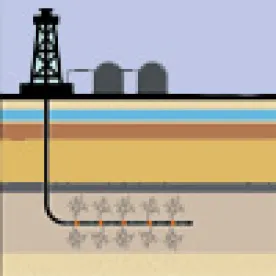Brief Overview
On March 20, 2015, three years after its initial proposal, the Department of Interior’s Bureau of Land Management (BLM) finalized new regulations applicable to hydraulic fracturing activities on federal and Indian lands. BLM previously released a draft proposed rule in May 2012 and revised draft in May 2013.
Key aspects of the final rule include requirements to: (1) request approval of hydraulic fracturing before commencement of operations; (2) disclose chemicals after completing hydraulic fracturing activities (preferably via FracFocus); (3) perform well integrity and cement evaluation tests and obtain approval if cement remediation is required; (4) use steel tanks for the storage of recovered waste fluids from hydraulic fracturing; and (5) supply information on estimated fractures and existing wellbores to reduce the risk of impacts to existing wells, i.e., “frack-hits.”
The Independent Petroleum Association of America (IPAA) and the Western Energy Alliance filed lawsuits the same day challenging the rule. The state of Wyoming filed suit in the U.S. District Court for the District of Wyoming on March 26, 2015. The final rule is effective on June 24, 2015.
Background and Rule Development
BLM’s existing regulations applicable to oil and gas activities performed on federal and Indian lands are set out at 43 CFR 3162.3-1 and Onshore Oil and Gas Orders 1, 2 and 7. DOI believed that the existing rules were outdated when compared to current oil and gas practices, including the more prevalent use of hydraulic fracturing in combination with directional drilling. Additional catalysts for the current rule included: (1) the Natural Gas Subcommittee of the Secretary of Energy’s Advisory Board 2011 recommendation that the BLM undertake a rulemaking to ensure well integrity, water protection, and adequate public disclosure; (2) the American Petroleum Institute’s 2009 guidance document titled “Hydraulic Fracturing Operations-Well Construction and Integrity Guidelines, First Edition, October 2009,” commonly known as HF1, to provide guidance and highlight industry recommended practices for well construction and integrity for those wells that will be hydraulically fractured; and (3) recent developments in state regulatory programs, including those found in Pennsylvania, California, Colorado and Wyoming.
Applicability
The final rule applies to oil and gas operations on public lands (which include split estate lands, i.e., lands where the surface is owned by an entity other than the United States), as well as operations on Indian lands.
Operators with leases on Federal lands must comply with both BLM’s regulations and with state operating requirements, including state permitting and notice requirements to the extent they do not conflict with BLM regulations.
To address concerns from states and tribes about possible duplicative efforts, the final rule provides that in situations in which specific state or tribal regulations are demonstrated to be equal to or more protective than BLM’s rules, the state or tribe may obtain a variance. Such a variance will allow for enforcement of the more protective state or tribal rule. DOI’s process for evaluating the stringency of state or tribal programs and granting such variances remains to be seen.
BLM’s Cost Analysis of the Rule
BLM estimates that the compliance cost will be about $11,400 per well. BLM estimates that on average this equates to approximately 0.13 to 0.21 percent of the cost of drilling a well.
New Requirements
This final rule establishes new requirements to ensure wellbore integrity, protect water quality, and enhance public disclosure of chemicals and other details of hydraulic fracturing operations. The rule requires an operator planning to conduct hydraulic fracturing to do the following:
-
Submit detailed information about the proposed operation, including wellbore geology, the location of faults and fractures, the depths of all usable water, estimated volume of fluid to be used, and estimated direction and length of fractures, to BLM with the APD or a Sundry Notice and Report on Wells (Form 3160-5) as a Notice of Intent (NOI) to hydraulically fracture an existing well;
-
Operators must submit a proposal for hydraulic fracturing to BLM for approval via an APD or NOI. The operator may submit an application for a single well or for a group of wells.
-
Design and implement a casing and cementing program that follows best practices and meets performance standards to protect and isolate usable water, defined generally as those waters containing less than 10,000 parts per million of total dissolved solids (TDS).
In rulemaking comments, industry had previously expressed concern that the requirement to protect usable water as defined would result in significantly increased costs because protecting water with TDS levels up to 10,000 ppm would require running casing and cement much deeper than it is currently run. The comments took the position that there is little value in protecting waters with TDS levels greater than 5,000 ppm, because it is not suitable for human, agricultural, or industrial uses.
-
Monitor cementing operations during well construction via cement evaluation logs (CELs).
-
For both the intermediate and production casing strings where they serve to protect usable water, the operator must either cement to the surface or run a CEL to demonstrate that there is at least 200 feet of adequately bonded cement between the deepest usable water zone and the formation to be fractured;
-
For any well completed via an APD that does not authorize hydraulic fracturing operations, operators are required to submit a cement monitoring report to the BLM at least 48 hours prior to commencing hydraulic fracturing operations;
-
A BLM authorized officer may approve the hydraulic fracturing of the well only if the documentation submitted provides assurance that the cementing was sufficient to isolate and to protect usable water. BLM may require additional tests as deemed necessary, including verifications, cementing, or other protection or isolation operations.
-
-
Take remedial action if there are indications of inadequate cementing, and demonstrate to BLM that the remedial action was successful;
-
The operator must notify BLM of the inadequate cement within 24 hours of discovering it and submit a plan to BLM requesting approval of remedial action to achieve adequate cement.
-
The operator must also verify that the remedial action was successful with a CEL or other method BLM approves in advance.
-
-
Perform a successful mechanical integrity test (MIT) prior to the hydraulic fracturing operation;
-
Monitor annulus pressure during a hydraulic fracturing operation;
-
Manage “recovered fluids” (produced and flowback waters) in rigid enclosed, covered or netted and screened above-ground storage tanks that do not exceed 500 bbl capacity, with very limited exceptions that must be approved on a case-by-case basis;
-
Disclose the chemicals used to BLM and the public following hydraulic fracturing, preferably via FracFocus, with limited exceptions for material demonstrated through affidavit to be trade secrets;
-
Provide documentation of all of the above actions to BLM.
-
BLM may require baseline water testing and other BMPs via conditions for approval (COA).
Key Changes from the 2012 and 2013 Proposals
Key changes to the final rule include:
(1) The allowable use of an expanded set of cement evaluation tools to help ensure that usable water zones have been isolated and protected from contamination. This change was responsive to many industry comments that took issue with BLM’s proposal to require a specific type of cement log for every well even though cement evaluation logs (CELs) can be difficult to interpret properly and often yields false positives;
(2) Replacement of the “type well” concept to demonstrate well integrity with a requirement to demonstrate well integrity for all wells;
(3) More stringent requirements related to claims of trade secrets exempt from disclosure, including requirements to submit an affidavit containing specific information explaining the reasons for the claim for protection;
(4) More protective requirements to ensure that fluids recovered during hydraulic fracturing operations are contained, including a requirement to manage recovered fluids in rigid enclosed, covered, or netted and screened above-ground tanks. The proposed rule would have allowed storage in lined pits;
(5) Additional disclosure and public availability of information about each hydraulic fracturing operation; and
(6) Revised records retention requirements to ensure that records of chemicals used in hydraulic fracturing operations are retained for the life of the well. The final rule also provides opportunities for BLM to coordinate standards and processes with individual states and tribes to reduce administrative costs and to improve efficiency.




 />i
/>i

